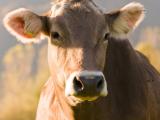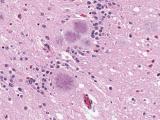Oct 26, 2004 (CIDRAP News) US and Japanese negotiators have reached general agreement on steps for resuming their beef trade after a 10-month interruption caused by the discovery of a case of bovine spongiform encephalopathy (BSE) in Washington state last December.
Under the agreement announced Oct 23, Japan will import US beef only from cattle younger than 21 months of age as a precaution against BSE, or mad cow disease, according to the US Department of Agriculture (USDA). The agency estimated it will take several weeks to iron out details and restart trade.
BSE experts say the incubation period for BSE is such that the disease is very unlikely to be found in cattle younger than 30 months old. But two cases in animals 21 and 23 months old reportedly were discovered in Japan, the USDA said, and Japan has been testing all its cattle for BSE before releasing the meat for sale. Recently the Japanese decided to stop testing cattle less than 21 months old, because BSE has not been found in cattle that young.
Japanese Foreign Minister Nobutaka Machimura called the agreement "a very good step toward the final resolution in reopening the beef trade," according to an Oct 24 Agence France-Presse report. US Secretary of State Colin Powell said the situation "is not resolved" but called the agreement "a major step forward."
Japan was the largest importer of US beef before the BSE case, buying about $1.7 billion worth in 2003, according to the USDA. About 10% of American beef is exported. USDA estimates that at least 70% of the 35 million US cattle slaughtered each year are less than 21 months old.
Other elements of the new agreement, according to the USDA, are as follows:
- Specified risk materialstissues most likely to harbor the BSE agent in infected animalswill be removed from all carcasses to be used for export.
- The age of US cattle will be determined by production records, birth records, and the USDA's physiologic grading system.
- To define the criteria for the grading system, the USDA will conduct a study of the relationship between the age and physiologic characteristics of cattle.
- The United States will resume importing Japanese specialty beef. (That trade, involving a very expensive, high-quality type of beef, amounted to about $250,000 in 2001.)
- The two countries and a group of international animal health experts will review the agreement next July and consider modifications.
"Trade between the two countries will resume following completion of regulatory processes in both countries," the USDA said in a news release. "Japan now is revising domestic regulations to alter its BSE cattle testing requirements and other procedures. The United States will initiate rulemaking procedures relating to importation of Japanese specialty beef."
Verifying the age of cattle was reported to be a major issue in the negotiations. At a news conference, J. B. Penn, USDA under secretary for farm and foreign agricultural services, explained that it's not possible to have a birth certificate for every calf born in the United States, with its large cattle herds spread over wide areas. But there are individual birth records for some animals, while herd records and artificial insemination records provide approximate birth dates for others, he said.
"We have agreed that we will use all of these production records, and we will augment that with determination of livestock age by physiological means, meaning by a grading system which looks at the particular characteristics of the carcass and determines the animal's age," Penn said, as quoted in the news conference transcript.
Dr. Charles Lambert, USDA deputy under secretary for marketing and regulatory programs, said the taste and tenderness of beef are related to physiologic maturity, and physiologic maturity was incorporated in the USDA's beef grading system in 1965 for that reason.
Lambert said the USDA, working with Japanese officials, will develop a study "to show the relationship between physiological and chronological age," with the aim of ensuring that only carcasses of cattle younger than 21 months will be used for export. Penn said plans call for completing the study within 45 days.
Penn said 81% of US beef cattle are no more than 20 months old at slaughter, with most of them 16 to 18 months old. The grading system will be used as "added insurance to make sure that no animal 20 months or older would be shipped to the Japanese market," he said.
Penn expressed hope that the scheduled review of the agreement next July will lead to further easing of restrictions on beef exports. He said the animal health experts to be involved in the review, including officials from the World Health Organization and the World Animal Organization for Animal Health (OIE), will consider new research findings and the results of expanded BSE surveillance in the United States.
"We think this review in July 2004 will be very important and then we hope, following that, we can eventually return to the normal trade patterns that we had before BSE was first discovered" in the United States, Penn said.
See also:
Oct 23 USDA news release
http://www.usda.gov/documents/NewsReleases/2004/10/0465.doc
USDA question-and-answer bulletin
http://www.usda.gov/documents/NewsReleases/2004/10/qa0465.doc
Transcript of Oct 23 press conference
http://www.usda.gov/documents/NewsReleases/2004/10/0466.doc


















